A PEEP AT THE PRINT-SHOPS.
CONTINUED.
Messrs. ComeAoHr's rooms exhibit much that is excellent, and a good deal that is new. Mr. ConSiNs, the mezzotint engraver, has put forth two fine specimens of his talent in the portraits of Sir ilstley Cooper, from Sir THOMAS LAWRENCE, and of Mr. Faraday, the eminent chemist, from PicitEasnILL,.__excellent as likenesses and admirable as works of art. The mezzotints of this artist have a richness, depth, and softness of tone, which, with the addition of a brilliancy of effect, render them extremely pleasing to the eye. The advantages which Mr. Conn-Ns derived from having executed many of LAWRENCE'S pictures Juicier the superintendence of the accomplished painter himself, have given him greater skill in trans- ferring the tone and effect of the picture, as well as the style and expression of the head, to the plate. His mezzotint of Ilfr. Croker has never been equalled for painter-like manner and identity of character.
Mr. TURNER, the mezzotint engraver, has put forth a portrait of Sir THOMAS LAWRENCE, painted as well as engraved by himself. The fore- head and eyes are those of CANNING, but the mouth and nose and lower part of the face resemble more the late President. One does not know which to think of while looking at the portrait, and it produces a strange effect. We cannot suppose an artist of Mr. TURNER'S reputation guilty of foisting on the public a Lazirencified bead of CANNING; but if it is a painting of his own, we can only say that the artist must have had Mr. CANNING in his eye during the progress of the work. A much more satis. factory proof of this eminent engraver's ability in mezzotint is afforded us in the portrait of the late Archbishop of Canterbury, MANNERS SUTTON, in his robes, from a painting by Homan, which is just completed. The Gentle Shepherd, by WILKIE, engraved by STEWART, is a pleasing and appropriate companion to the print bearing the same title, and also illustrating the delightful pastoral of ALLAN RAMSAY. 'We have only one objection, and it is, that the characters and costumes seem rather more mo- dern than the date of the poet's description. The picture represents the interior of a Scottish shepherd's cottage at dawn ; the "Gentle Shepherd" is smoking, and the two lassies are performing their rustic toilet. It is an accurate, and therefore an interesting delineation of Scottish peasantry, and is well engraved in a broad and effective style, and with a broad line, which suits the nature of the subject better than a more defined and delicate style of execution.
The little Queen of Portugal, Donna Maria H. has been graphically libelled, (if truth be a libel) by Mr. FOWLER ; • and his libel has been cir- culated in mezzotint by S. W. REYNOLDS. It is an ungracious portraiture of premature womanhood, characterized by Bourbon imbecility, with a va- cant animal expression akin to idiotcy. The Duke of Clarence's face has been "taken in vain" by M. W. SHARPE, and set upon the shoulders of a naval officer, who with hat in one hand and glass in the other is standing by the capstan in the act of toasting "The Navy."—What between flattery and buffoonery, poor royalty gets sadly bedaubed. The hand which alone could elevate regal character and add refinement to courtly grace is now mouldering clay.
We have seen two more specimens of Sir Thomas Lawrence's Sketches, engraved by Mr. LEWIS being the portraits of a son and daughter of the Duke of HAMILTON, pleasing and elegant ; and a sweet profile of the painter's niece, Miss MEnEDurn. Mr. LANE has lithographed a sketch of the head of the great artist made by himself in 11112, and now published under the sanction of the family. It is interesting as the resemblance of and a sketch by LAWRENCE ; but it wants character, and is not remark- able for beauty of drawing. Mr. Co [ISIS'S is employed upon a mezzotint engraving from the portrait left behind him of this distinguished painter ; and for its,appearance we look with anxious interest.
(To be continued.)



















 Previous page
Previous page